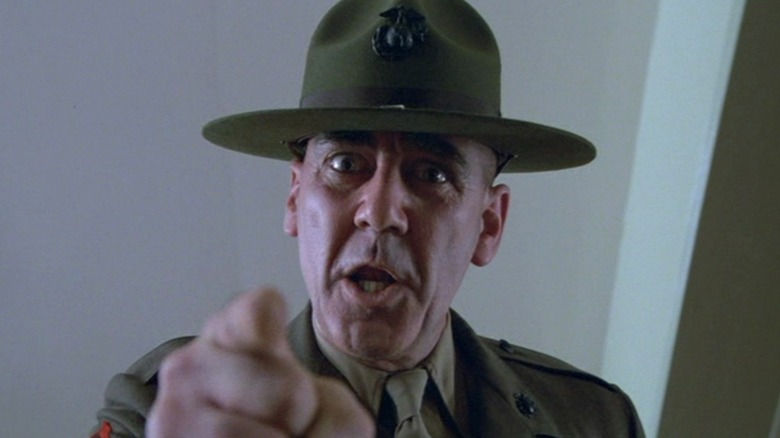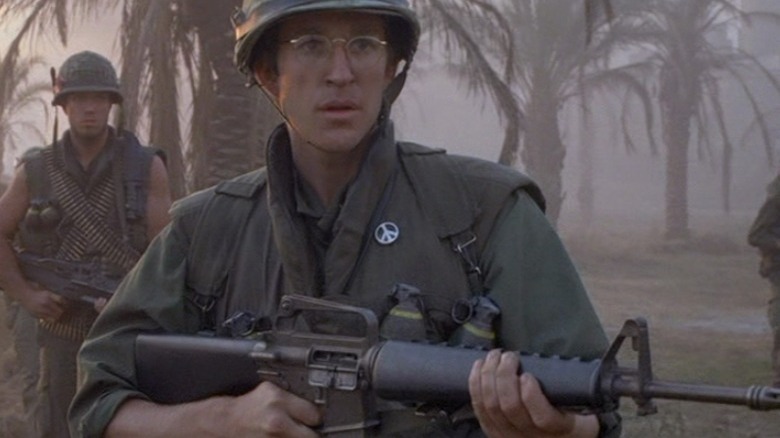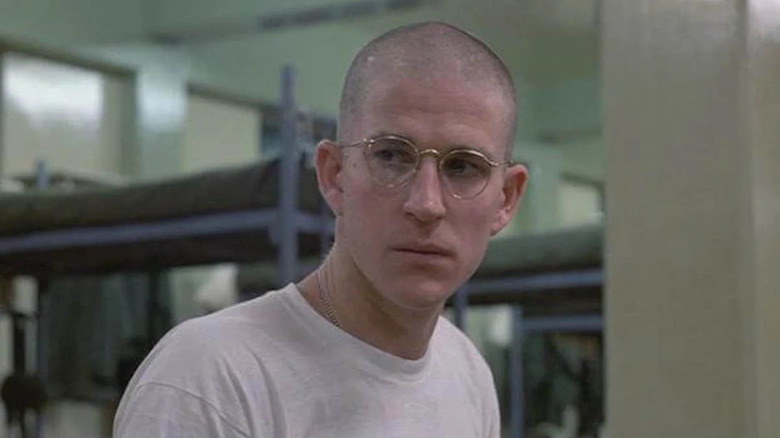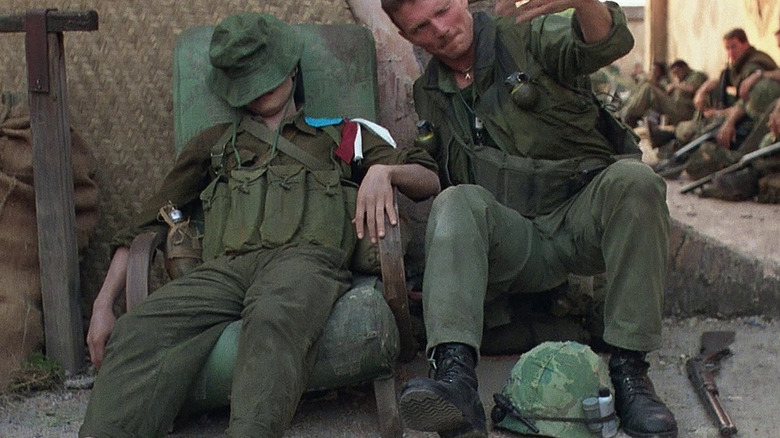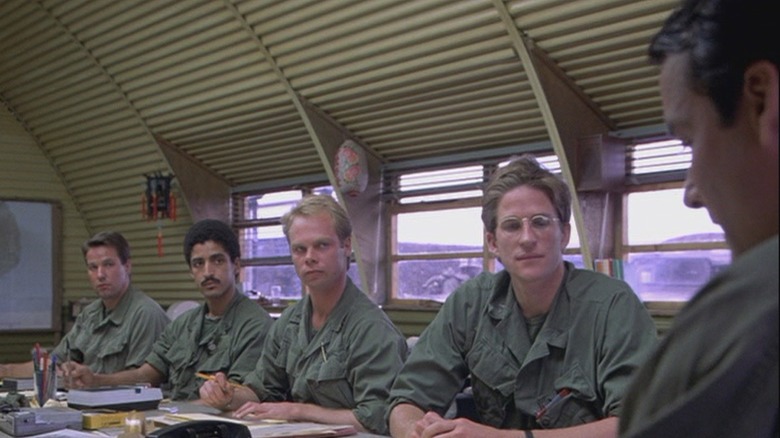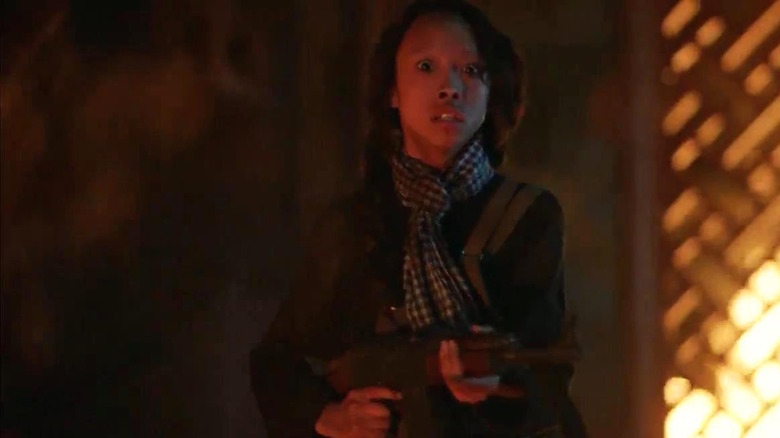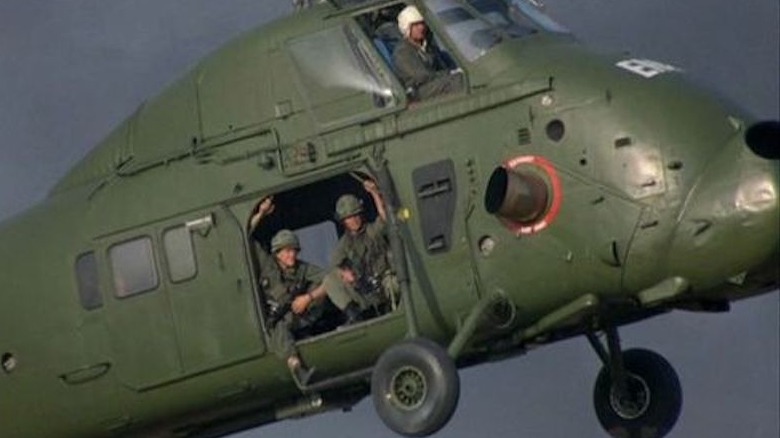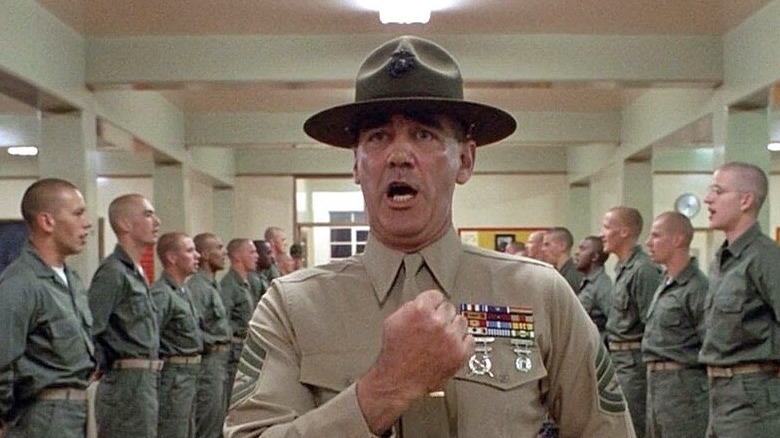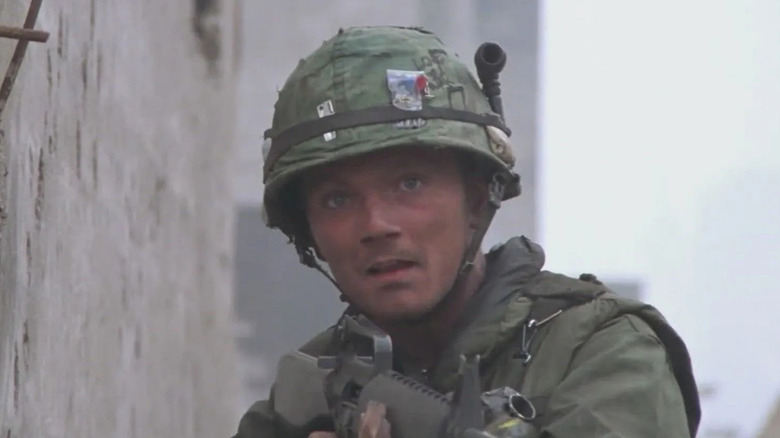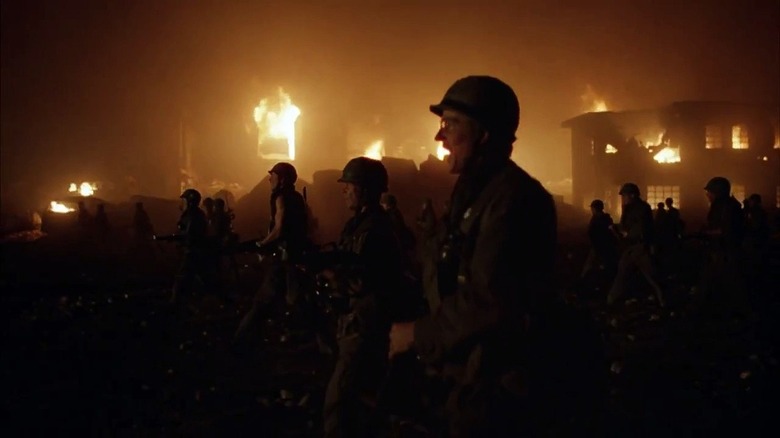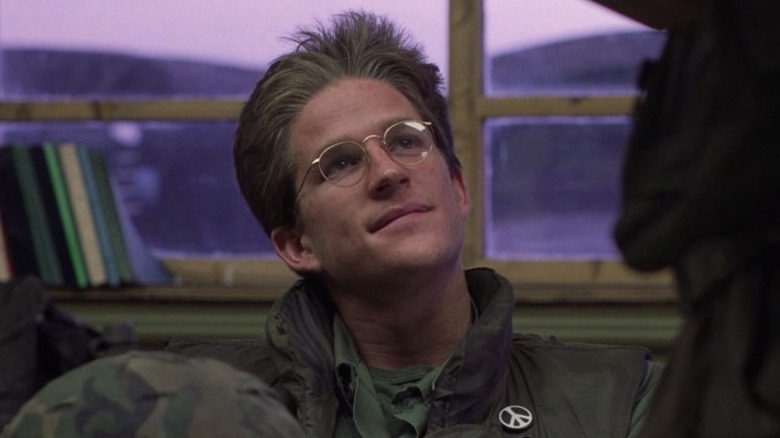Times Full Metal Jacket Got History All Wrong
The Vietnam War has inspired many films, books, and songs. "Full Metal Jacket," however, is considered by many to be one of the best movies about the war. People with actual experience in US military boot camp have pointed to the accuracy of the first part of the film, focused on basic training at Parris Island. Of course part of that accuracy is based on the fact that the drill sergeant is played by R. Lee Ermey, a real Sergeant who actually wrote the insults he uses in "Full Metal Jacket."
After drill camp, the rest is essentially historical fiction with the story taking priority over accuracy. It does mostly follow the general historical arc of the Vietnam war in early 1968. That said, there are some parts where the movies gets things historically wrong. Some of these inaccuracies are in blink-and-you-missed-it details though with director Stanley Kubrick's well-documented and obsessive penchant for details none of them can be dismissed. Others are due to a desire on the part of the director to deal with deeper themes than the plot of what's happening onscreen. Whatever the reason, here are some parts where "Full Metal Jacket" was wrong about history.
Inaccurate weapons
To start off, some of the weapons used were inaccurate but you'd only notice if you were really paying attention and knew about guns. That said, no doubt most veterans would notice this, especially if they kept up with the development of the M16 after Vietnam.
During that war, the M16 was the standard-issue weapon for the US Military. It was all black, and uniform throughout the soldiers who carried it. In the scene when 8-Ball gets shot by the sniper during the sniper encounter in Hue City, Cowboy's M16 has a silver-colored firing assembly, the nickel assembly for an M16. That wasn't around on the Vietnam War M16. Neither was the pistol grip on Joker's M16, something that came with the M16 A2, which was introduced in the 1980s. Sure, they both catch the eye more and most people probably didn't notice but still, the standard-issue gun should be not only standard but also accurate to the timeline.
A book appears before its time
Ursula Le Guin's "The Word for World is Forest" is seen on Joker's bedside. This is during basic training in "Full Metal Jacket," which takes place before 1968. Sure, it would be appropriate that Joker would be reading a book about how human greed ruins a pristine alien wilderness. Especially since the author Le Guin was inspired by her protests of the Vietnam war. The problem is, the book didn't come out until 1976. (It's worth acknowledging the story first appeared in 1972 as a novella, which is still four years after the "Full Metal Jacket" timeline).
This could be chalked up to a simple mistake. Perhaps it was. Yet Kubrick is notorious for his meticulousness. No doubt he wanted to put the book on Joker's bedside specifically for the reasons mentioned above. He just had no problem jumping forward 8 years. Or perhaps the cause of Joker's enlightened philosophy about the pointlessness of the war is that he could travel into the future to see the final result.
No black Leather boots in Vietnam
The US military's black leather boots is a pretty classic bit of GI gear. That said, by 1965 the US Military had replaced the black leather boot with jungle boots for the Vietnam war. Yet throughout the Vietnam fighting scenes in "Full Metal Jacket," which take place in 1968 (though the press office might have been late 1967, and was towards the rear), black leather boots abound.
The jungle boot was made to handle the mud and the moisture of Vietnam. They could drain water, and resist mildew. This was a type of early waterproof breathable footwear, made for handling jungles as first discovered during the Pacific Theater. This is why everybody in Vietnam would have been wearing jungle boots, not the black leather boots they're wearing from Da Nang in "Full Metal Jacket." The ever-battling Lusthogs who are discovered in he field and followed to Hue city would have definitely had jungle boots.
Joker mentions he'd heard the Tet Ceasefire might not be upheld
During the scene at the press office in Vietnam, Joker tells his editor at Stars and Stripes that he'd heard from a friend in intel that the Tet ceasefire might not be upheld. Obviously this is foretelling the Tet Offensive and it makes Joker and intel seem like they're brilliant. Yet the truth is, the Tet Offensive caught everybody off-guard.
Joker's foresight is a bit of revisionist history, where people look into the past and see the obvious warning signs. The truth is there had been hints that the US knew the VC military was massing for a big attack. That said, they did not know when or how big it would be. There is certainly no proof that anybody seriously suspected they would blow off their own holiday. It would not have been something a reporter would have been onto, nor would he have pinpointed the fact that the Tet Ceasefire was going to be rejected. This is a situation where Kubrick has used hindsight to create a false wisdom that never existed.
The VC AK-47 would not have been accurate enough to snipe
The climax to "Full Metal Jacket" has a young VC woman sniping members of the Lusthog Squad. Her shots are pretty perfect, luring in one bit of prey after another. When Doc Jay points out the sniper to Animal Mother, the sniper perfectly lights him up. Then she kills Cowboy by shooting through a couple hundred yards and the hole in a building.
When it's revealed the sniper was actually pretty young, it becomes tough to believe she would be so lethal at such a distance since it would have been difficult for her to have attained such a level of training and accuracy at her age. This is especially true with that particular rifle — the AK-47, by many accounts, is not considered a very accurate rifle. The distances in that scene were several hundred yards, in an urban environment. An AK-47 is not a sniper rifle, yet Kubrick makes it look like an instrument of death that could hit a target at hundreds of yards with precision. This is yet another issue of "Full Metal Jacket" either not understanding historical weapons or not caring about realism.
British choppers in Vietnam?
England had no participation in Vietnam during the war. They also didn't supply materiel since the US has long had its own weapons and vehicles. So it is surprising in "Full Metal Jacket" when the transport choppers used are British. Even a fresh coat of US paint can't hide that.
The US military used UH-34D and CH-46 helicopters for most of their transport during the Vietnam War. The British developed a helicopter similar to these, the Wessex 60. These Wessex 60s are what Kubrick uses for USMC helicopters in "Full Metal Jacket." They have a different nose from the US helicopters and again, they are British. Are there similarities? Sure. Would the US use a British chopper in Vietnam? Nope. Since Kubrick filmed "Full Metal Jacket" in England, he probably had easier access to the British helicopter. It was just a movie chopper that never made it into that war.
Messed up timeline
In "Full Metal Jacket", there's a scene towards the end of basic when they're singing happy birthday to Jesus. This is obviously a reference to Christmas. Shortly after, Joker graduates and is sent off the Vietnam as a reporter. When he's seen next his hair has grown out yet he still seems a bit new. People regularly comment that he hasn't seen any action.
Even more, Joker is talking about the Tet Ceasefire, and is present for the Tet Offensive. This timeline is all confusing. The Tet Offensive occurred in late January, 1968. So either Joker grew hair and was somewhat established with "Stars and Stripes" in less than a month or he was woefully under-experienced for his time in country.
"Full Metal Jacket" the movie is based on Gustav Hasford's semi-autobiographical book, "The Short-Timers." That term means somebody with a short time left in his deployment. This would imply perhaps that Joker was coming up on his 13th month, which would maybe make sense except that the idea he'd get sent into field during this big push is perhaps a bit unbelievable, and the idea that he'd go to fight in the Battle of Hue during his last month is certainly incredulous.
Real Battle of Hue was a long, house to house fight
The culminating scene in "Full Metal Jacket" is the Battle of Hue, one of the most savage battles of the war. The movie shows it as a burnt-out husk with seemingly just one sniper guarding the place. In actuality the Battle of Hue was a long, involved battle against a vast, dug-in enemy. This battle was known for being a house-to-house search to clear North Vietnam out. Different from what we see in "Full Metal Jacket."
Even more, it was, according to the above-referenced article, the first urban battle for the Marines since the Korean War. Which goes back to the earlier point that it's strange there were no jungle battles in "Full Metal Jacket". But the idea that there was just a single sniper in a single building and this battle was quickly ended after taking out just a single straggler is way off.
Soldiers didn't leave Hue City singing Mickey Mouse
The film ends with US soldiers walking through a seemingly-conquered Hue City singing the Mickey Mouse March. Not only was this city not taken back in just a day, or even a couple days, or a month. There is also no documented instance of US soldiers singing the Mickey Mouse March, before, during, or after a super bloody battle.
Obviously at this point Kubrick is making a statement about America though one of its top exports, Mickey Mouse. There is certainly a bent satisfaction that comes from the juxtaposition of this jolly song and the horrors of war. But there are enough real celebrations of victory and marches in the Marine Corps that they would not have chosen to sing about Mickey. So to close such an accurate depiction of the inner turmoil of the Vietnam with some fictional song never sung at Victory is laughable.
Joker's glasses wouldn't have been military-permitted
Of course Joker's glasses are a central part of "Full Metal Jacket." They give him an intellectual gravitas and a radical geek flare. They make him look super cool. They also never would have been allowed in basic, much less the war.
Standard metal-framed glasses were regularly destroyed throughout the military process. For that reason, the US military started working with companies to make new eyewear. Eventually they adopted an acetate-framed standard issue pair of glasses, called by many the "Birth Control Glasses." It makes sense that the US military wouldn't have people heading to battle in thin metal-framed glasses. Joker would totally have the acetate glasses, especially when going out into the field. If not, his glasses would have been destroyed by the rigors of the war. Either way, there would be no cool metal hipster specs.
